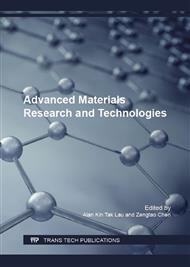p.41
p.46
p.57
p.62
p.69
p.74
p.79
p.87
p.92
Study on Copper Particle Removal from Silicon Surface Based on Binary Systems Consisting of High Pressure Carbon Dioxide and Solvents
Abstract:
In this study, a mathematical model is constructed to calculate the forces of a single copper particle on the silicon surface in CO2+solvent systems. The equilibrium separation distance (ESD) and net adhesion force (NAF) are used to discriminate the difficulty of particle removal. In general,the bigger the NAF is, the more difficult the cleaning is. Series values of ESD and NAF are obtained by altering the particle radius, temperature, pressure and solvent type. The value of NAF decreases with the increase of pressure and increases with the increase of the particle radius. When the particle radius is 110 nm, the variations of ESD and NAF with system pressure in CO2+acetone system indicate that, the ESD always exhibits a maximum in the regions of temperature range (303.15-323.15K) and higher pressure could facilitate the particle removal. When the pressure is super high, the lower temperature get the smaller NAF. Besides, the variations of ESD and NAF with system pressure are gained from the contrastive analysis of three different solvents including acetone, isopropanol and methanol at 313.15K. The calculation results indicate that acetone and isopropanol, especially the isopropanol,have good particle removal abilities with respect to methanol which NAF value is biggest and tends to be unstable.
Info:
Periodical:
Pages:
69-73
Citation:
Online since:
November 2016
Authors:
Price:
Сopyright:
© 2017 Trans Tech Publications Ltd. All Rights Reserved
Share:
Citation:


